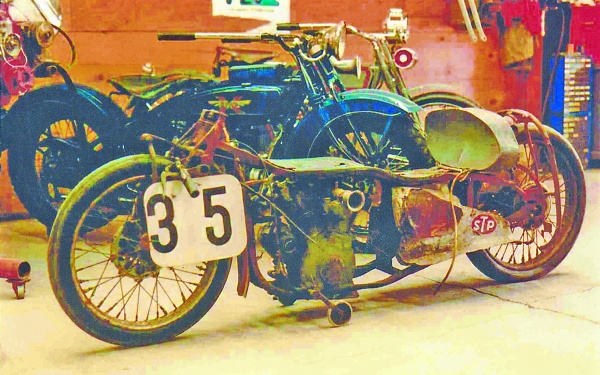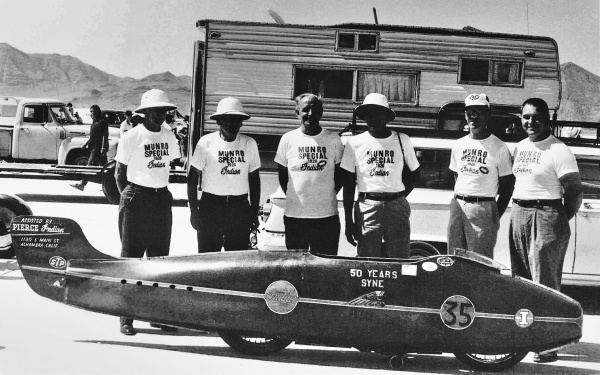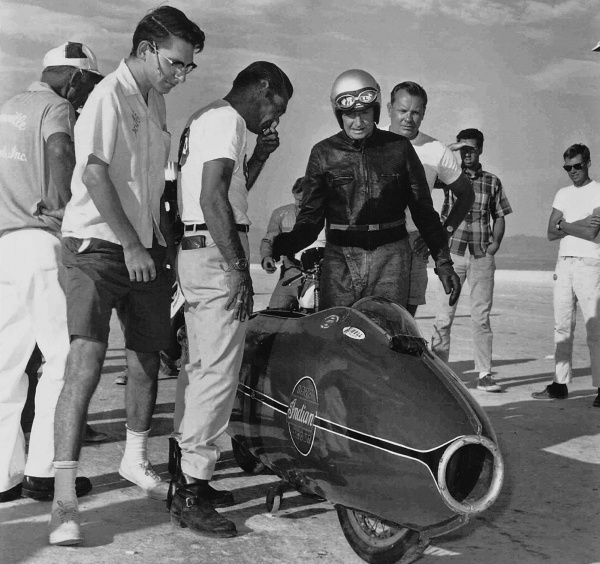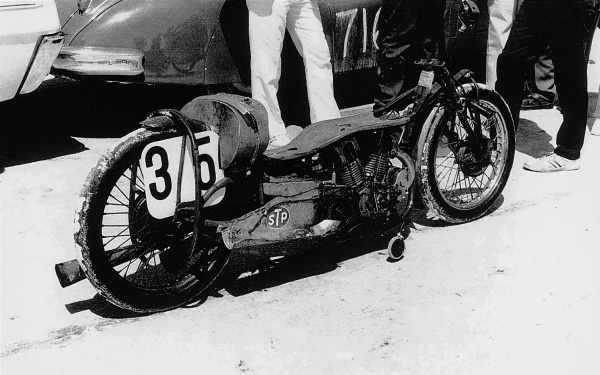
How does it feel to be the keeper of the most famous motorcycle in the world?
Ask Tom Hensley. His family has owned Burt Munro’s Indian streamliner since way before it became famous. Hensley manages the bike as part of a small motorcycle collection for the family, in honor not only of Munro, but also for Hensley’s late brother, Dean.
First about Munro. If you haven’t seen the 2005 movie The World’s Fastest Indian, starring Anthony Hopkins, set aside your next available evening and rent the movie. To anyone interested enough to leaf through a book titled The Harley in the Barn, the movie is a must-see.
Munro was born in Invercargill, New Zealand, in 1899, and from childhood was interested in all things mechanical: cars, trucks, airplanes, boats, and motorcycles. Living on his family’s farm did not give him much opportunity to see many vehicles. Growing up in a remote area, though, did teach him that he needed to be self-sufficient: he sometimes had to build parts from scratch if he wanted to get a job done.
In 1920, as a 21-year-old, Munro purchased a brand-new Indian Scout motorcycle, which had a 600cc engine and a top speed of 55 mph. This modest speed only kept the young man intrigued for so long, and by 1926, he had already begun modifying the bike.
His prowess in modifying and riding bikes won some acclaim. At one point he competed in professional Speedway races and eventually set seven New Zealand speed records, beginning in 1938.

Munro set his sights on a land speed record, and traveled to the Bonneville Salt Flats in Utah, for the annual Speedweeks trials to investigate the scene and plan his strategy. He continued to modify his bike, and in 1962, with its engine punched out from 600cc to 800cc, Munro set a record of 178.95 mph. In 1966 he set another record.
The people who frequent Bonneville’s SpeedWeeks took a liking to Munro. They knew he was broke, but they also knew he was a genius. Folks befriended him, loaned him tools, and gave him spare parts and a place to sleep.
The Pierce family was one who took Munro in. They were from San Gabriel, California, and owned Pierce Indian, one of the leading parts and service centers after the Indian factory closed its doors in 1953. During the 10 years that Munro competed at Bonneville, the Pierces allowed him to store his bike at their facility when he traveled back home to New Zealand. They also gave him parts and allowed him to use their shop to work on his bike prior to bringing it to Bonneville.

“The Pierces sponsored Burt in 1967, which is why the fiberglass bodywork had a ‘Pierce Indian of San Gabriel’ painted on the bike’s tail,” Hensley said.
“Burt started to run on nitro when he came to the States, so every winter when he brought his engine back home to rebuild, the Pierces bottled up nitromethane in wine bottles and sent them along, because he couldn’t get it in New Zealand.” The nitro is also why he kept burning holes in pistons, because he was casting them himself in the backyard from probably inferior materials.
In addition to pistons, Munro made his own cylinder barrels, flywheels, and numerous other items. In fact, the hoops that supported the fiberglass body were actually recycled fence post stakes. Munro also built connecting rods out of old Ford tractor axles.
Munro’s effort in 1967 seems to have brought all the lessons of the previous years together. If racing was a young-man’s sport, Munro knew nothing about it; he was 68 years old and his motorcycle was 47.
By now his Indian’s engine had grown to 950cc. When his turn to race finally came, he turned in a two-way average of 183.586 mph, finally breaking the under-1000cc world record.

Munro ran at Bonneville a couple of more times, but he finally hung up his helmet in 1970, when he was 71 years old. When he left America for the last time, he gave his beloved Indian to the Pierce family as a thank you for all the years of assistance.
For a while the Pierces displayed the World’s Fastest Indian in their showroom, then relegated it to the warehouse, and ultimately to the elements outside, where the decades of Munro’s loving modifications slowly deteriorated into the ground.
Enthusiast Gordy Clark purchased the Indian from the Pierces, but just put it into storage. Remember, at this time Munro’s motorcycle was just a beat-up old racer, not very interesting to even the most serious motorcycle collectors. This was before the modern antique bike craze really took off. It was a curiosity, nothing more.
Enter Dean Hensley. Dean, Tom Hensley’s older brother, was a rising motorcycle racing star. At just 18 years old he was already making a name for himself on the road racing circuit. One day he was racing at the El Sonora track when he wrecked and was run over by another bike.
“When my parents got the call about my brother, I rode to the hospital with them,” Tom Hensley said, 12 years old at the time. “Hell, I didn’t even know what the word paralyzed meant. They had him in traction, but managed to somehow drop him to the floor when he first arrived. But even though he was paralyzed from the chest down, he bounced back like a flower.”
Dean Hensley and his younger brother Tom, who at 13 became his brother’s full-time caregiver, went into business.
“He went to the fine art school at Pasadena City College to learn how to pinstripe and paint flames,” Tom said. “One thing led to another and we began selling antique-looking mirrors that we sold to pubs.” According to Tom, the mirror business was earning $2 million a year in the early 1980s.
“He had known about the Indian for years,” Tom said, referring to the historic bike that had been stored in a neglected state among Gordy Clark’s 300-bike collection. Dean purchased the bike in 1986, soon after selling the antique mirror company.
“He had gone to an auction, maybe it was at Hershey, and saw that old streamliners were beginning to sell for substantial money,” Tom said. “That’s when he decided to try and buy the old Burt Munro bike.”
After the purchase, Munro’s Indian sat around for a few years as Dean gathered enough information and parts to begin restoration. “The body was beaten down like nobody’s business,” said Tom. “As we say out here on the West Coast: it was crusty. We have detailed photos of the restoration. Since the bike sat outside for years, four frame tubes filled with water and rusted out.”
Tom said that the photographs are proof they own the actual Indian. He said there are collectors in New Zealand who claim to own the actual World’s Fastest Indian, but he said that was actually a chassis mock-up that Munro used to test his engines. Tom Hensley said Munro’s bike never left the United States once it was shipped here in 1962.
Dean Hensley had the bike restored by master restorer Steve Huntsinger. The bike was never completely reassembled because Dean wanted to be able to sit on the bike at start-up. So special hand-controls were adapted and half the body was not installed.
“The left side of the body hung on my garage wall for 20 years,” said brother Tom. “The fiberglass had settled, so getting it fitting back together was like fixing Marty Feldman’s eyes. We had to mount it to a board, let it sit in the sun, and every day turn the set screws one-quarter turn to get the body to move back into place.”
Dean brought his now-restored Indian streamliner to a Davenport, Iowa, swap meet and decided to start the bike after it hadn’t run in 20 years. They had built an Indy-type starter that mounted on the countershaft, and Dean could operate it with hand controls.
“They had never de-tuned the engine, so they were still running high compression,” Tom said. “My brother revved it up running on methanol and snapped a connecting rod.” Afterward, the bike was relegated to a static show bike.
Sadly, Dean Hensley, who had worked so hard and accomplished so much in the worlds of art, business, and motorcycles, was killed in an auto accident in May 1992. Tom continued to show the bike after his brother’s passing, but other collectors made him upset.
“What pissed me off was that I had collectors trying to buy my brother’s bikes even before I could get him buried,” he said. “So I said, ‘You know what guys? You guys ain’t getting shit.’ That’s why I’ve kept all his stuff.” A big brother is a big brother—Tom keeps the bike out of love and respect for Dean.
Besides Munro’s Indian, the Hensley family collection includes the original Globe of Death theatrical Indian; an original Isle of Man overhead cam prototype racer; Gene Ryan’s factory overhead valve hill-climber; and the last Indian to win at Ascot Park.
Another memento from Dean is the 1958 Ford Ranchero equipped with hand controls. “I drove it just the other day,” Tom said.
In the spring of 2011, Tom received a phone call from the organizers of the Pebble Beach Concours d’Elegance. They said if he could prepare the streamliner to running condition, he could enter it in the prestigious show.
“We were already in the process of getting the bike running with new rods and pistons when Pebble Beach called,” he said. “They said it had to be in running condition in order to come to the show, so we built brand-new cylinders from scratch and had the bodywork fitted exactly the way Munro had it mounted when he ran for the record in 1967.”

By August, the bike was completed. The Pebble Beach organizers conducted a thorough analysis of the bike’s restoration, making sure it was authentic before being invited to be displayed on the lawn. It was displayed at Pebble Beach with only one-half the bodywork mounted. “Once you mount the entire body, all the work and craftsmanship of the frame and engine is hidden.”
Slight modifications were made so the bike could be started in the event if it was invited to the trophy presentation. For instance, Munro had no carburetor venturi, making idling impossible. “It was like sucking soda through a funnel,”
Tom said. “It wouldn’t run at low rpms.”
It’s a good thing Tom got the bike to operate, because it was called onto the stage for a first place trophy in the racing motorcycle category. “We started it up,” he said. “My brother was the last person to run it, and almost 25 years later, I was the next.”
Having won the show of all shows, the Hensley family is considering what to do next. “This is not my bike, it belongs to my family’s collection,”
Tom is quick to point out. “I have two sisters and a brother. They have been gracious enough to help keep the collection of my brother’s bikes together.”
They are now considering selling the collection, which includes about a dozen bikes, as a single unit. Since New Zealanders consider Burt Munro to be their John Wayne, I’d be surprised if someone down there didn’t buy it. But parting with the family collection won’t be easy. Tom truly cares who owns these bikes next.
“After all, this is my brother’s legacy,” he said.

What an amazing bloke. And thank god they nailed it with the movie. Sometimes you just wish you were someone like this.
Another great article! Thanks for the post.
Burt Munro was undeniably a man with a dream and he wasn’t about to let that dream die. He is an inspiration to anyone with a dream and my hat is off to him.
The Pierce family: that sounds like Sammy Pierce, the man they used to call Mr. Indian. I remember reading an article about him in Cycle World (I believe) August 1967. Very interesting life he had. It would be nice to get my hands on a copy of that issue.
Theres 2 copies of August 67 Cycle World on Ebay right now.
It is the July issue of 1967 that has the article about Sammy Pierce and my grandfathers ’34 4 cylinder on the cover.
Thanks for the correction, Scott. It’s been 46 years since I had the magazine and it was awfully dog-eared when it finally disappeared. I well remember the ’34 Indian on the cover. Is that bike still in the family?
Great story! I visited NZ a couple of years ago and saw a couple of Burts bikes. ehayes.co.nz has the original Munro special.
Can anyone really know which one is real? In NZ, they are damn sure the Hayes Hardware store is the real original, and it looked more than a mock-up chassis… I tend to believe that the one at Hayes in Invercargill is the original.
Burt decided to leave the chassis and streamliner body in the US so he didn’t have to keep shipping the complete motorcycle back and forth. He would only take the engine back to New Zealand with him. Burt eventually welded up a second chassis in New Zealand to test the motor whilst he was at home. Burt was offerred alot of cash for his bike so he built up a second engine to sell with the original frame and body.
Burt’s original engine (used in setting the records) is still in New Zealand and we hope will always remain here.
Funny, I just picked up the blueray version of the movie, one of the most inspiring I’d seen in a long time. This and Sir Lawrence’s bike would be in my holy grail to view let alone ride or own.
Great story. For more, I think ‘World’s Fastest Indian’ is a must-see for anyone who reads BarnFinds, whatever their preference is for vehicles. The scenes at Bonneville are magical and were filmed in fantastic light, close up. You can almost taste the salt. The fellowship between the racers depicted in the film is something for every racing organization’s members to aim for.
When I started to read about Munro’s achievement it seemed truly amazing: his Indian was 47 years old, and his speed record still stands. I have wondered whether no one will challenge it as a tribute to him.
Also, Munro was 68 at the time he set that record. I have a special affinity for old guys who can still do it: Munro setting that record at 68, Paul Newman at 70 the oldest winner in a major sanctioned race, driving on the team that won their class at the 1995 24 Hours of Daytona. Those guys and the others I don’t know about yet sure have my admiration.
I also have a special affinity for old Indians. My first ride on a bike was on the back of my Uncle’s big Indian. I was pretty small and had to keep my legs out stiff and away from the hot pipes. The incredible sounds were scary for a small boy, and nobody wore helmets in those days, so I never forgot that ride. It sure stamped Indian bikes in my memory forever.
Touché Dolphin. I am at the age that Juan Manuel won his World Championships and he has been the single most important influence on my persevering in an extremely ageist industry (advertising – no naughty stick please). Newman and Munro set the next benchmark for me now; the mind is stronger than ever, just make sure the body can support it. Happy new year to you and all the other most excellent conversationalists I have met on this site.
Thanks for the history and clarifying the TV Film.
I have photos of the one in NZ and not sure which is real. But the one over there does not look as modified as this one so?
My friends Dad used to run at Bonneville and knew Burt real well.
rich
I went to the hardware store in Invercargill before the movie came out and saw the Indian and the Velocette which Burt also raced. I also tracked down where his house was. The family that lived there then were the people who bought the land after Burt died. They said they found tons of buried parts that they took to the scrapper.
I remember in the early 70’s going to the cinema with my grandfather to see a movie about a bear “Toklat”…. There was a short film preceding it, the same film was packaged with the DVD Release in the US. When the movie came out, my friends saw it before I did, they urged me to go with cryptic statements like “this guy is SO YOU! You have to see it, I can’t explain it.”
I went with my son, and in the opening credits, the shelf “offerings to to god of speed” had my son poking me saying “Dad! He has your same shelf!” I found myself excited at the cast piston scene, and realized I was probably the only guy in the cinema that day who appreciated it.
When I bought the DVD, I went to that special features section and my blood went cold as the opening credits to the film scrolled, and I remember that day 35 years before not even knowing what an engine was just waiting to get to the main feature, watching “my shelf” roll across the screen. To thing a single, solitary viewing…a flash could influence someone so much is amazing to me.
I never met Burt Munro, but his story being told influenced me in way so much later in my life it’s astounding. One day, regardless of what I or Burt think…we will sit and swap speed secrets, if only for a short while, before we go away forever.
F/PRO Car220, Crewchief – F/PS in Work, looking for that a Red Hat.
Anthony Hopkins made Bert just come alive. A great character actor in a wonderful story. As for the remaining Monro Bonnevile records, there is a feeling that they should be left unchallenged, at least for some time. The comments about Bonneville entrants helping other racers is basic to the salt flat racers. The web has a great story about the fastest Saab Sonnet on the salt that also brings out the fellowship culture.
Thanks for a great story,I met Burt in the early 1960’s and watched him race his Velocette at the Teretonga track in Invercargill competeing on the flying 1/4 mile sprint.
I took photo’s of Burts Indian at the Muriwai beach NZ speed trials in Auckland,they are published in BURT MUNRO INDIAN LEGEND OF SPEED written by the late George Begg.A great read and worth collecting for any Burt Munro fan.
George was a lifelong friend and fellow competitor of Burts.George was also a builder of single seater F5000 racing cars in thier day.
thanks again for a great story,regards MEL MULQUEEN Sydney Australia.
There are pics of both the indian motor and velocette motor bolted in the velocette chassis , during late 50s early 60s , it has a horse shoe shape on the seat post full of holes.
The Indian chassis has the original style kick shaft cast , no kicker and has prince forks . The engine number of indian = 50R627 , the original 1920 number at purchase. There are 2 velocette bikes , 1 was sold in 2008 , also with a spare velocette motor .
This bike is the original frame minus the motor. Burt would leave his streamliner in the USA and bring the motor back for development in his alternative frame. He was offered alot of money (to him) for his indian so he built up another motor and sold it and the frame to a collector in the USA. The original motor is still in NZ with his alternate frame. I would love to own the bike in this article (as it was still built by Munro) but I think the one in NZ with the original motor has to be more special. By the way, there is a new boom out about Burt called The Lost Interviews by Neill Birss. Great book. The Begg book trumps it though..
hi danny,the george begg book is a good read,george was a personal friend of burt’s for many years so he got the good oil.i met george begg at lakeside raceway north of brisbane in qld,was with my cousin gwyn endicott-davies who knew george and introduced me to him.
he was writing the book at the time and i told him i had some photo’s of burt and the indian taken at muriwai beach near auckland,where burt was trying for a nz speed record but sadly the engine blew apart.my photo’s are in georges book,so glad he used them.regards,mel mulqueen.
The Burt Munro Worlds Fastest Indian Sold In California In april of 2018 for over over $1,000,000.00 USD
B.L.Palmer. No, it didn’t. It’s still in Invercargill.
Paul d’Orléans keeps an updated list on his site of the World’s Most Expensive Motorcycles. It’ll be huge news if one of Burt’s bikes gets sold. Either the Indian or the Velocette.
https://thevintagent.com/2017/04/26/the-worlds-most-expensive-motorcycles/
Read the article again. The real record setting motorcycle never left the USA after it was shipped here the first time. My parents knew the family that owned it after Burt was done with it.
Bert took the engine back with him and left the frame and fairing because it was cheaper than taking it all back with him. He built another frame for the Indian motor in NZ for testing purposes. The overly restored fairing and frame in the US (it’s beautiful) has a mock engine that Bert built because he wanted the money.
The USA Engine is stamped “Munro” on LH case and the RH case timing gear cavity is stamped inside as per normal. The NZ Engine is stamped 50R627 from 1920. Roger Donaldson’s book uses photos from Burts own scrap book collection. Photos of the modified frame, show it was shared between the Velocette and the Scout Engines. That doesnt take anything away from the USA bike, that was purpose built for Bonneville
Good stories, brings back a lot of memories from the past. We would lift the chassis minus the engine as Bert would pack the motor away in pieces in his suit case, the bike with body would be displayed in our store in both San Gabriel and our Monrovia store waiting for Bert’s return the next summer, yes Hensley version is the real one, had to dust it off before Bert’s return. Glenn Pierce
Glenn, you gotta arrange as much of your dads info as well as your own memories. Jud Carriker had a manuscript for a Indian book in 1951, he died in 1970, I contacted the family recently they know nothing, did they throw it out in 1970 ? chances are yes.